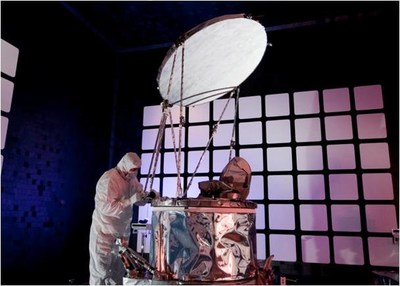BOULDER, Colo., April 12, 2017 /PRNewswire/ -- The Global Precipitation Measurement (GPM) Microwave Imager (GMI), designed and built by Ball Aerospace for NASA's Goddard Space Flight Center, is entering its fourth year of service. Designed as a 3-year mission, GMI has performed successful operations on orbit while exceeding its performance requirements. The GPM spacecraft that hosts the GMI instrument is a joint effort between NASA and the Japan Aerospace Exploration Agency (JAXA) to provide frequent, near-global precipitation information critical for improving weather forecasting and protecting lives and property.

"Ensuring mission success and good value for programs is how we help our customers go beyond," said Rob Strain, president of Ball Aerospace. "The GMI instrument is a perfect example of this, as it has surpassed its design life and continues to deliver valuable science and weather data."
The GMI instrument is a multi-channel, conical-scanning, microwave radiometer serving an essential role in the near-global-coverage and frequent-revisit-time requirements of the GPM mission.
"NASA's Global Precipitation Measurement mission is improving our understanding of precipitation patterns around the world, and it will continue to do so well into the future," said Chris Scolese, director of NASA's Goddard Space Flight Center. "The GMI now serves as a reference standard for calibrating precipitation measurements in the GPM constellation."
Ball designed, built and tested GMI, and provided pre- and post-launch support for the instrument. GMI's high-frequency channels measure small particles of ice, snow and rain in the atmosphere. When combined with the JAXA-built Dual-Frequency Precipitation Radar instrument, these instruments provide comprehensive data to produce global rain maps and climate research data products. GMI enables the core spacecraft to serve as both a precipitation standard and a radiometric standard for the other spacecraft in the GPM constellation. By serving as the calibration standard in the GPM constellation, Ball's GMI instrument is helping to ensure the accuracy and precision of other instruments.
For more than five decades, Ball Aerospace has designed and built weather and environmental spacecraft and sensors to provide actionable intelligence to civilian and military weather forecasters. GMI's design is based on proven Ball-built microwave sensors, including the Shuttle Radar Topography Mission (SRTM), Spaceborne Imaging Radar-C (SIR-C), GEOSAT Follow-On (GFO) and the Submillimeter Wave Astronomy Satellite.
Ball has played key roles on numerous national and international programs that make critical measurements of the physical environment. These include designing and building the spacecraft for the next-generation Joint Polar-orbiting Satellite System-1 (JPSS-1), designing and building the spacecraft for the Suomi National Polar-orbiting Partnership (Suomi NPP), and building the CloudSat spacecraft. Ball also designed and built the Ozone Mapping and Profiler Suite (OMPS) instrument aboard Suomi-NPP, and a second OMPS that will fly on the JPSS-1 weather satellite, as well as the polar follow-on missions. Ball also built the LIDAR and wide-field camera instruments, the communications equipment, and integrated the payload for NASA's CALIPSO satellite program, which has orbited the Earth more than 43,000 times in its nearly 11-year history as it studies how clouds and aerosols impact the Earth's climate.
Ball Aerospace pioneers discoveries that enable our customers to perform beyond expectation and protect what matters most. We create innovative space solutions, enable more accurate weather forecasts, drive insightful observations of our planet, deliver actionable data and intelligence, and ensure those who defend our freedom go forward bravely and return home safely. For more information, visit www.ball.com/aerospace or connect with us on Facebook or Twitter.
Ball Corporation (NYSE:BLL) supplies innovative, sustainable packaging solutions for beverage, food and household products customers, as well as aerospace and other technologies and services primarily for the U.S. government. Ball Corporation and its subsidiaries employ 18,450 people worldwide and 2016 net sales were $9.1 billion. For more information, visit www.ball.com, or connect with us on Facebook or Twitter.
Forward-Looking Statements
This release contains "forward-looking" statements concerning future events and financial performance. Words such as "expects," "anticipates," "estimates," "believes," "targets," "likely" and similar expressions typically identify forward-looking statements, which are generally any statements other than statements of historical fact. Such statements are based on current expectations or views of the future and are subject to risks and uncertainties, which could cause actual results or events to differ materially from those expressed or implied. You should therefore not place undue reliance upon any forward-looking statements and any of such statements should be read in conjunction with, and, qualified in their entirety by, the cautionary statements referenced below. The company undertakes no obligation to publicly update or revise any forward-looking statements, whether as a result of new information, future events or otherwise. Key factors, risks and uncertainties that could cause actual outcomes and results to be different are summarized in filings with the Securities and Exchange Commission, including Exhibit 99 in our Form 10-K, which are available on our website and at www.sec.gov. Additional factors that might affect: a) our packaging segments include product demand fluctuations; availability/cost of raw materials; competitive packaging, pricing and substitution; changes in climate and weather; competitive activity; failure to achieve synergies, productivity improvements or cost reductions; mandatory deposit or other restrictive packaging laws; customer and supplier consolidation, power and supply chain influence; changes in major customer or supplier contracts or a loss of a major customer or supplier; political instability and sanctions; currency controls; and changes in foreign exchange or tax rates; b) our aerospace segment include funding, authorization, availability and returns of government and commercial contracts; and delays, extensions and technical uncertainties affecting segment contracts; c) the company as a whole include those listed plus: changes in senior management; regulatory action or issues including tax, environmental, health and workplace safety, including U.S. FDA and other actions or public concerns affecting products filled in our containers, or chemicals or substances used in raw materials or in the manufacturing process; technological developments and innovations; litigation; strikes; labor cost changes; rates of return on assets of the company's defined benefit retirement plans; pension changes; uncertainties surrounding geopolitical events and governmental policies both in the U.S. and in other countries, including the U.S. government elections, budget, sequestration and debt limit; reduced cash flow; ability to achieve cost-out initiatives and synergies; interest rates affecting our debt; and successful or unsuccessful acquisitions and divestitures, including with respect to the Rexam PLC acquisition and its integration, or the associated divestiture; the effect of the acquisition or the divestiture on our business relationships, operating results and business generally.

SOURCE Ball Aerospace